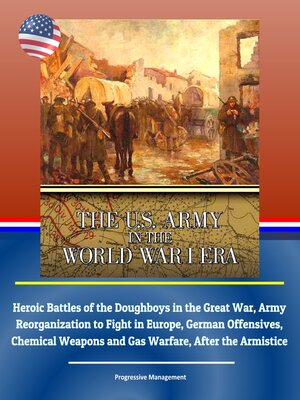The U.S. Army in the World War I Era
ebook ∣ Heroic Battles of the Doughboys in the Great War, Army Reorganization to Fight in Europe, German Offensives, Chemical Weapons and Gas Warfare, After the Armistice
By Progressive Management

Sign up to save your library
With an OverDrive account, you can save your favorite libraries for at-a-glance information about availability. Find out more about OverDrive accounts.
Find this title in Libby, the library reading app by OverDrive.



Search for a digital library with this title
Title found at these libraries:
| Library Name | Distance |
|---|---|
| Loading... |
This excellent report has been professionally converted for accurate flowing-text e-book format reproduction. It is designed to provide Army personnel with a concise, authoritative, yet also readable history of the institution in which they serve with an overview of U.S. Army in the years leading up to and including the First World War. A century ago, the great powers of Europe became engulfed in what was then called the Great War. It signaled a new age in armed conflict in which mass armies supported by industrial mass production brought an unprecedented level of killing power to the battlefield. By the time the United States entered the war in 1917, the combatants were waging war on a scale never before seen in history. The experience defined a generation and cast a long shadow across the twentieth century. In addition to a tremendous loss of life, the war shattered Europe, bringing revolution, the collapse of long-standing empires, and economic turmoil, as well as the birth of new nation-states and the rise of totalitarian movements.
The modern U.S. Army, capable of conducting industrialized warfare on a global scale, can trace its roots to the World War. Although the war's outbreak in August 1914 shocked most Americans, they preferred to keep the conflict at arm's length. The United States declared its neutrality and invested in coastal defenses and the Navy to guard its shores. The U.S. Army, meanwhile, remained small, with a regiment as its largest standing formation. Primarily a constabulary force, it focused on policing America's new territorial possessions in the Caribbean and Pacific as it continued to adapt to Secretary of War Elihu Root's reforms in the years following the War with Spain. It was not until June 1916 that Congress authorized an expansion of the Army, dual state-federal status for the National Guard, and the creation of a reserve officer training corps.
In early 1917, relations between the United States and Germany rapidly deteriorated. The Kaiser's policy of unrestricted submarine warfare threatened American lives and commerce, and German meddling in Mexican affairs convinced most Americans that Berlin posed a danger to the nation. In April 1917, the president, out of diplomatic options, asked Congress to declare war on Germany. But the U.S. Army, numbering only 133,000 men, was far from ready. The president ordered nearly 400,000 National Guardsmen into federal service, and more than twenty-four million men eventually registered for the Selective Service, America's first conscription since the Civil War. By the end of 1918, the Army had grown to four million men and had trained 200,000 new officers to lead them. As it expanded to address wartime needs, the Army developed a new combined-arms formation—the square division. Divisions fell under corps, and corps made up field armies. The Army also created supporting elements such as the Air Service, the Tank Corps, and the Chemical Warfare Service. The war signaled the potential of the United States as not only a global economic power, but also a military one.
1. Introduction * 2. The Prewar Army, 1899–1917 * 3. Reorganization of the Army Bureaucracy * 4. Reorganization: The Regular Army and the Militia * 5. The Army on the Mexican Border * 6. War in Europe and the National Defense Act of 1916 * 7. At War: An End to Neutrality * 8. The U.S. Army Arrives in Europe * 9. The War Effort in the United States * 10. German Offensives and the AEF's First Battles * 11. The Meuse-Argonne Offensive, September–November 1918 * 12. After the Armistice * 13. The American Army And The Great War







